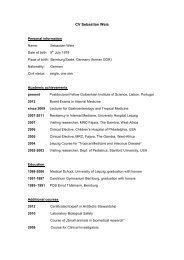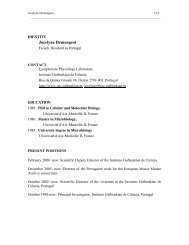organisation - the Instituto Gulbenkian de Ciência
organisation - the Instituto Gulbenkian de Ciência
organisation - the Instituto Gulbenkian de Ciência
- No tags were found...
You also want an ePaper? Increase the reach of your titles
YUMPU automatically turns print PDFs into web optimized ePapers that Google loves.
BEHAVIOURAL<br />
NEUROSCIENCE<br />
THIS GROUP IS A MEMBER OF THE CHAMPALIMAUD NEUROSCIENCE PROGRAMME AT THE IGC<br />
Marta Moita Principal Investigator<br />
PhD in Neuroscience, Universida<strong>de</strong> do Porto, Portugal<br />
Post-doctoral Fellow, Cold Spring Harbor Laboratory, USA<br />
Principal Investigator at <strong>the</strong> IGC since 2004<br />
link to external website<br />
We are interested in un<strong>de</strong>rstanding <strong>the</strong> neural mechanisms un<strong>de</strong>rlying behavioural<br />
plasticity using a combination of behavioural, pharmacological, molecular<br />
and electrophysiological tools. In particular, we are studying how prior experience<br />
and how social interactions shape behaviour. To this end, we are studying<br />
fear; both how animals learn to fear cues that are predictive of aversive events<br />
or threats, and how fear can be socially transmitted, i.e. how animal respond to<br />
<strong>the</strong> distress of con-specifics. We chose fear learning since it is conserved across<br />
species, entailing fast robust learning and very long lasting memories. We are<br />
also studying <strong>de</strong>cision-making in <strong>the</strong> context of social interactions, using game<br />
<strong>the</strong>ory to test how rats learn and evaluate <strong>the</strong> payoffs that result from <strong>the</strong> interaction<br />
with ano<strong>the</strong>r individual.<br />
NEURAL MECHANISMS OF TRACE AUDITORY FEAR CONDITIONING<br />
This project focuses on <strong>the</strong> role of different memory systems in trace auditory<br />
fear conditioning (tAFC). We hypo<strong>the</strong>sised that <strong>the</strong> mechanism un<strong>de</strong>rlying <strong>the</strong><br />
association between a tone and a shock <strong>de</strong>pends on <strong>the</strong> length of <strong>the</strong> trace<br />
interval memory and in <strong>the</strong> case of long intervals <strong>the</strong>y rely on episodic memory<br />
between <strong>the</strong> two stimuli, where in <strong>the</strong> case of a short interval rats rely on working<br />
memory.<br />
GROUP MEMBERS<br />
Kensaku Nomoto (Post-doc)<br />
Ana Pereira (PhD stu<strong>de</strong>nt)<br />
Andreia Pereira (PhD stu<strong>de</strong>nt)<br />
Elizabeth Rickenbacher (PhD stu<strong>de</strong>nt)<br />
Marta Guimarãis (PhD stu<strong>de</strong>nt)<br />
Scott Rennie (PhD stu<strong>de</strong>nt)<br />
COLLABORATORS<br />
Hugh Blair (University of California Los Angeles (UCLA), USA)<br />
Alfonso Renart (Champalimaud Foundation, Portugal)<br />
Susana Lima (Champalimaud Neuroscience Programme, Portugal)<br />
FUNDING<br />
Fundação para a Ciência e a Tecnologia (FCT), Portugal<br />
Champalimaud Foundation, Portugal<br />
We have tested <strong>the</strong> role of contextual learning in auditory trace fear conditioning.<br />
We found that <strong>de</strong>creasing <strong>the</strong> saliency of <strong>the</strong> training environment disrupts<br />
learning to fear a tone that prece<strong>de</strong>s shock by several seconds and that inactivating<br />
<strong>the</strong> hippocampus does not <strong>de</strong>crease it fur<strong>the</strong>r. In addition we are studying<br />
<strong>the</strong> role prefrontal cortex in trace conditioning by performing single-unit<br />
recordings in this structure during learning.<br />
COOPERATION IN SOCIAL DILEMMAS IN RATS<br />
Game <strong>the</strong>ory has constituted a powerful tool in <strong>the</strong> study of <strong>the</strong> mechanisms of<br />
reciprocity. Having shown that, in a Prisoner’s Dilemma game, rats shape <strong>the</strong>ir<br />
behaviour according to <strong>the</strong> opponent’s strategy and <strong>the</strong> relative size of <strong>the</strong><br />
payoff resulting from cooperative or <strong>de</strong>fective moves, we now aim at dissecting<br />
<strong>the</strong> mechanisms.<br />
We tested whe<strong>the</strong>r rats learn to coordinate in a game where coordination with a<br />
conspecific leads to highest number of rewards. We have found that rats learn to<br />
coordinate and that <strong>the</strong>y are not simply following <strong>the</strong> o<strong>the</strong>r rat, since <strong>de</strong>creasing<br />
<strong>the</strong> reward for coordinating leads to a significant <strong>de</strong>crease in coordination.<br />
NEURAL MECHANISMS OF SOCIAL TRANSMISSION OF FEAR IN RATS<br />
This project aims at investigating <strong>the</strong> mechanisms un<strong>de</strong>rlying social transmission<br />
of fear (STF) in rats, i.e. how rats respond to <strong>the</strong> fear displayed by a<br />
conspecific. In or<strong>de</strong>r to unravel <strong>the</strong> neural circuit un<strong>de</strong>rlying STF, we will first<br />
<strong>de</strong>termine how prior self-experience with shock contributes to STF and what<br />
are <strong>the</strong> sensory cues that mediate this process.<br />
We found that rats do not rely on visual cues, alarm calls or short range chemical<br />
signals to <strong>de</strong>tect fear in a conspecific. Instead, <strong>the</strong>y use auditory cues which are<br />
likely to signal <strong>the</strong> sud<strong>de</strong>n transition from motion to immobility. Through sound<br />
playback experiments, we found that <strong>the</strong> absence of movement-evoked sound<br />
was necessary and sufficient to induce fear in rats. In addition we have found that<br />
prior experience with shock is necessary, but not sufficient for vicarious fear.<br />
IGC ANNUAL REPORT ‘11<br />
RESEARCH GROUPS<br />
53






